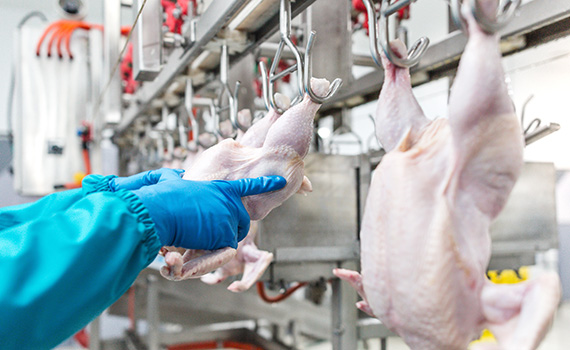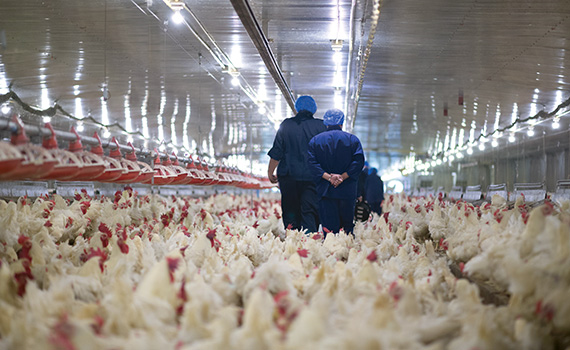USDA poultry inspections can help improve live production, processing

By Philip A. Stayer, DVM, MS, ACPV
Corporate Veterinarian
Sanderson Farms, Inc.
Some of us in the poultry industry might consider this statement — “I’m from the government and I’m here to help you” — an oxymoron. Fortunately, as a veterinarian for a major poultry company, I’ve found that inspectors from USDA’s Food Safety and Inspection Service (FSIS) not only make a huge contribution to food safety, their findings can also help bring about live-production and processing-plant improvements.
I’m a live-production veterinarian, but when something isn’t going as expected at a processing plant, I’m asked to make a visit. In such cases, I prefer to start out by meeting with the USDA veterinarian in charge.
First, I want to find out if the government veterinarian has poultry expertise. That’s not a knock on their expertise or professionalism. But as we know, US veterinary schools tend to focus on the big four — dogs, cats, horses and cows. It’s therefore not surprising to meet veterinarians with limited experience with broiler chickens. Once I know their background, I can offer my services as a board-certified poultry veterinarian if they have questions about pathology or diseases that they may be seeing for the first time.
Next, I usually review the condemned carcasses with the USDA veterinarian so we can discuss whatever lesions the government inspectors found that caused them to condemn a carcass. These inspectors have the ultimate diagnostic opportunity: They get to examine every bird’s interior, while production veterinarians only get to look at the inside of a small portion of the population. USDA inspectors can therefore provide the earliest warning of new disease. Their work can also yield valuable insights about the poultry-health programs we have in place.
One good example is the Georgia 08 infectious bronchitis virus. We weren’t experiencing field mortality or lost weight gain, but USDA inspectors noticed excessive respiratory exudates at processing. The additional information was invaluable and helped us make adjustments to our vaccination strategy. It also underscored the value of working closely with USDA inspectors.
Awkward interventions
Nevertheless, we all know from experience that veterinarians don’t always agree. That can lead to some healthy debate, but it can also create some uncomfortable situations. For example, sometimes, live-production veterinarians find themselves awkwardly intervening between USDA inspectors and company processing-plant employees. It’s important for us, as production veterinarians, to keep our cool in these situations and use the information at hand to get to the root of the problem.
For example: At one plant, company employees complained about what they believed were excessive USDA condemnations due to ascites. When I visited the plant the next day, I met first with the front-office manager and then with the USDA veterinarian in charge. The USDA veterinarian described thoracic cavities obscured by fluid, complying with the USDA definition of ascites.
Armed with this information, I took a closer look at the evisceration process and found many carcasses with free blood in their intraclavicular spaces but not ascitic fluid as I expected. Furthermore, the carcasses did not have other classic signs of ascites — no dilated hearts; no enlarged, rounded livers; no straw-colored fluid under liver capsules or in pericardial sacs.
I dissected several carcasses and, in the process, cut my finger on sharp vertebral bone fragments. The broken vertebrae were always located in the spine region between the lungs. Something was apparently breaking the backs of the chickens.
Mechanical misalignment
The plant manager and I walked back to the receiving dock to observe cage unloading, conveyance and shackling. All components seemed in good order. We watched birds calmly approach the stunner and receive adequate stunning.
Prior to the neck cutter, however, we found a mechanical misalignment with a tension wheel that was rubbing the birds in their mid-thoracic region rather than at their shoulders as designed. The manager immediately stopped the line, dropped the tension wheel and resumed processing. Suddenly, the hemorrhage stopped and so did condemnation for ascites. In this case, USDA inspectors proved helpful by leading us to a mechanical problem in the plant that needed correction.
Error rates
Still, misunderstandings are bound to occur from time to time. More often than not, my visits to the processing plant for condemned carcasses revealed no lesions that, in my view, warranted condemning entire carcasses in at least half of the whole birds condemned.
I’m not the only veterinarian who has found a 50% error rate. Lloyd Keck, DVM, of Zoetis, came up with similar results that he detailed in a Poultry Health Today article. He also calculated that for a producer processing 1 million 7-pound birds per week at 85 cents per pound, reducing the condemnation rate from 1% to 0.5% would save $1,160,250 per year.
Misdiagnoses
Some of the misdiagnoses are due to limitations imposed by USDA’s condemnation categories. The most commonly over-diagnosed condition is “sep-tox,” which inspectors may call when they see small, dark-muscled carcasses. USDA’s training manual1 says:
“Condemnation of carcasses with two pathological lesions, for example an airsacculitis lesion and [an inflammatory process] flap is not FSIS policy. Condemnation because of some dehydration without any other findings is not supportable. A number of factors should be considered before declaring a carcass septic. There should be a number of findings that cause you to conclude the ‘weight of evidence’ supports condemnation for septicemia.”
Now, most anyone would agree that small, dark-muscled carcasses are not appealing, but condemning an entire carcass for a systemic disease has ramifications beyond just that bird. For example, if feet are harvested, then several feet on either side of the condemned carcass must be discarded to ensure the identified bird’s parts are kept out of the human food chain. Not all small, dark-muscled birds, however, have sep-tox.
Another example of potential misdiagnosis is categorizing speckled spleens as “leukosis,” even though spleens may be speckled simply due to antigenic reactions — perhaps to dust or dander or other common allergens or irritants — that have nothing to do with tumor-generating viruses. If spleens are affected with no other gross lesions, then leucosis may be on the list of differentials — but it shouldn’t be the sole diagnosis.
Proving something other than Marek’s disease is almost impossible since every commercial chicken in the US is vaccinated with some type of Marek’s vaccine. On the pragmatic side, even if a chicken has leukosis, there’s no adverse impact on consumers, so perhaps this USDA condemnation category should be removed.
Despite unnecessary errors and condemnations, I have to say that USDA’s third-party oversight of food safety is valuable — to the industry and also to production veterinarians. The US has one of the safest food supplies in the world and that includes chicken meat. It’s clear, too, that a good working relationship between the poultry integrator and USDA personnel can help improve the diagnosis of disease and processing efficiency. That, in turn, benefits our entire industry.
1 Harvey Hunter, DVM, veterinary staff officer at FSIS’s Technical Service Center in Omaha, Nebraska, confirmed the policy in AskFSIS Incident 170309-000086, in an email to Douglas Fulnechek, DVM, Zoetis.
Posted on March 15, 2019
 We’re glad you’re enjoying
We’re glad you’re enjoying










